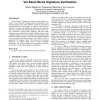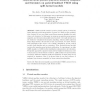58 search results - page 3 / 12 » Detection of New Malicious Code Using N-grams Signatures |
RAID
2005
Springer
15 years 4 months ago
2005
Springer
Abstract. Network worms are malicious programs that spread automatically across networks by exploiting vulnerabilities that affect a large number of hosts. Because of the speed at...
ACMSE
2004
ACM
15 years 4 months ago
2004
ACM
Most of today’s computers are connected to the Internet or at least to a local network, exposing system vulnerabilities to the potential attackers. One of the attackers’ goals...
ACSAC
2009
IEEE
15 years 5 months ago
2009
IEEE
—Validating function pointers dynamically is very useful for intrusion detection since many runtime attacks exploit function pointer vulnerabilities. Most current solutions tackl...
ICISC
2007
15 years 11 days ago
2007
VMM (virtual machine monitor) based system provides the useful inspection and interposition of guest OS. With proper modification of guest OS, we can obtain event-driven memory sn...
126
click to vote
CCS
2009
ACM
15 years 11 months ago
2009
ACM
Botnets are networks of compromised computers infected with malicious code that can be controlled remotely under a common command and control (C&C) channel. Recognized as one ...


